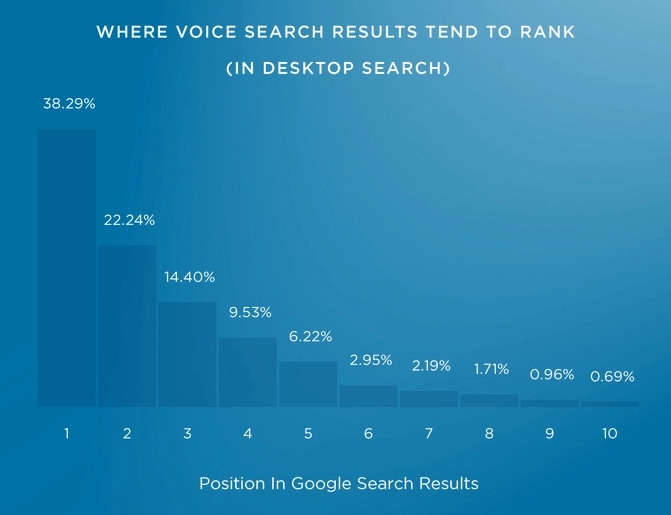With the growth in mobile voice searches digital marketing, including SEO, has moved to an AI predictive model. To keep pace with technology, the marketers have done several surveys and studies to get ahead of the emerging trend.
The range of virtual assistants, such as Siri, Cortana, Google Voice Search/Now, Amazon Alexa, and Google Home, are collectively training people to search using their voices and to become more “conversational” with search and mobile devices.
While the research is compelling, this technology is still too new to have a complete picture and/or set best practices for SEO specifically. However, there are several research studies from 2016- 2018 where a common theme has emerged.
NLP : Natural Language Processing
Voice technology is another step in the direction of improving the user experience with semantics. RankBrain from Google further develops the use of user intent via NLP and other algorithm factors.
Marie-Claire Jenkins, a Ph.D. in Natural Language Processing and Artificial Intelligence at the University of East Anglia, defines NLP:
"It is the area of computing that deals with words. Words form texts, texts form collections of many texts, leading to an awful lot of words. This "bag of words" needs to be analyzed so that a machine can make sense of them. If it can't, there is no way of retrieving information from the texts and so they are in effect useless.
Linguistic analysis is used to analyze and represent the texts. Once the computer can represent the language in some way (patterns, reoccurring words, synonymy...) the information in the texts can be manipulated. This mimics the human understanding of language. NLP is a subfield of artificial intelligence and computational linguistics."
Basically, Natural Language Processing (NLP) to recognize voice texture, interests, and behavior. With time, Google “learns” your language, accent, and other patterns in the way you speak, through your voice activated devices.
Now, and going forward Google’s RankBrain reinforces the AI used for voice searches, which focuses on the semantics and the wider contextual relevance of the user’s query.
Summary of Our Most Interesting Findings:
Voice technology is another step in the direction of improving the user experience with semantics. RankBrain from Google further develops the use of user intent via NLP and other algorithm factors.
Marie-Claire Jenkins, a Ph.D. in Natural Language Processing and Artificial Intelligence at the University of East Anglia, defines NLP:
"It is the area of computing that deals with words. Words form texts, texts form collections of many texts, leading to an awful lot of words. This "bag of words" needs to be analyzed so that a machine can make sense of them. If it can't, there is no way of retrieving information from the texts and so they are in effect useless.
Linguistic analysis is used to analyze and represent the texts. Once the computer can represent the language in some way (patterns, reoccurring words, synonymy...) the information in the texts can be manipulated. This mimics the human understanding of language. NLP is a subfield of artificial intelligence and computational linguistics."
Basically, Natural Language Processing (NLP) to recognize voice texture, interests, and behavior. With time, Google “learns” your language, accent, and other patterns in the way you speak, through your voice activated devices.
Now, and going forward Google’s RankBrain reinforces the AI used for voice searches, which focuses on the semantics and the wider contextual relevance of the user’s query.
- PageSpeed appears to play a major role in voice search SEO. The average voice search result page loads in 4.6 seconds (52% faster than the average page).
- HTTPS websites dominate Google’s voice search results. In fact, 70.4% of Google Home result pages are secured with HTTPS.
- Google prefers short, concise answers to voice search queries. The typical voice search result is only 29 words in length.
- Schema may not play a key role in voice search rankings. 36.4% of voice search results come from pages that use Schema (which is only slightly higher than the worldwide average of 31.3%).
- Authoritative domains tend to produce voice search results significantly more than non-authoritative domains. Fortunately, the mean Ahrefs Domain Rating of a Google Home result is 76.8.
- Content with high levels of social engagement tends to perform well in voice search. In fact, the average voice search result has 1,199 Facebook shares and 44 Tweets.
- Simple, easy-to-read content may help with voice search SEO. The average Google voice search result is written at a 9th grade level.
- We found that very few voice search results had the exact query in their title tag. So, creating individual pages for each voice search query doesn’t appear to be an effective voice search SEO strategy.
- The average word count of a voice search result page is 2,312 words. Therefore, Google tends to source voice search answers from long form content.
- Content that ranks highly in desktop search is also very likely to appear as a voice search answer. In fact, approximately 75% of voice search results rank in the top 3 for that query.

Optimization Techniques
Content
Content should be written at an easily understood level, on average a ninth-grade level, while being scannable for the key points of the page. Target keywords should be the long tail in nature and lead the user into schematic theming of the intent of the page.
- Use headlines
- Short paragraphs
- Separate out topics in a scannable format
Keyword research is the cornerstone of any content creation or optimization. When specifically targeting voice search.
Longer form content returns the top level results for voice search (so far), with over 2000 words per result. This may pose a problem for some of the top level landing pages on businesses’ website, however, as we move forward in creating new content length can become a higher priority.
Creating FAQ sections throughout the website is a way increase the opportunity for both voice search as well as queries that include “Who, What, Why, When or Where”.
Featured Snippets
Featured snippets (position 0) continue to be a significant benefit for URLs, the same is true for voice search results. Featured snippets are position zero and logically it makes sense to be the top result, in any type of search. *Roughly 41 percent of voice search results came from Featured Snippets.
To increase our chances of being selected for a featured snippet, MKG takes a multi-pronged approach that includes:
- Content that clearly answers the question.
- Clean code and tagging that Google can easily understand.
- Positive user engagement signals.
MKG has identified opportunities for optimization for a featured snippet response does improve if you follow the content organizational model outlined below.
First, repeat the question that is the query, or which is implicit in the query, clearly and prominently on your web page.
Directly following the question, provide a short, direct, clear answer to the question.
Then, provide more information, data, images and so on to answer the question as fully and completely as possible.
One way to structure your content is to use what journalists refer to as “the inverted pyramid.” When following the inverted pyramid model, your page starts with the most important information that answers the question, then transitions to more detailed information, and finally wraps up with a broader look at the topic or perhaps a case study or an example.

Image Credit: The Air Force Departmental Publishing Office (AFDPO) [Public domain], via Wikimedia Commons
SearchEngineland.com
Summary
Voice search is a new technology which will continue to modify how search engines evolve into voice and AI. While formatting specific content may increase the likelihood of inclusion in the results, there are no direct paths, on record yet. Common sense SEO rules still apply:
- Write for the visitors not search engines
- Use simple explanations and language
- Research your users/ visitors vocalize some common questions
- Use long term keywords to expand on the schematic theme of the page
- Optimize existing content to show in Featured Snippets
- Continue to follow best practices
- Create long-form content
Additional reading: Google's newly-published Voice Search Quality Guidelines.




